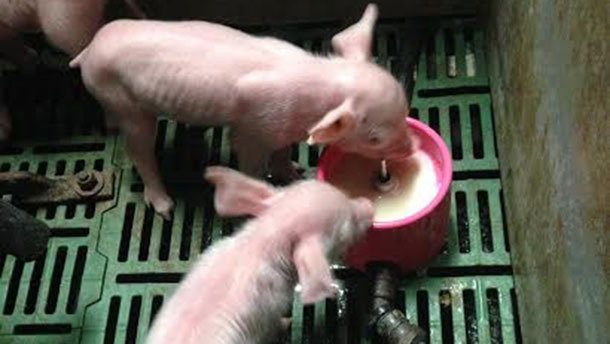We all know the genetic advances of hyper-prolific sows, and especially the changes brought about in the farrowing phase.
Hyper-prolificacy leads to increased litter sizes and greater variability in birth weights, leading to an excess of piglets and a greater proportion of small piglets.

Several management methods can be used in the farrowing rooms in order to wean the highest number of piglets and, more importantly, of the highest quality and with less weight variability at weaning.
Given that all procedures carried out with the excess piglets entail economic as well as performance disadvantages at 20 weeks of age, the ideal situation is that the sows wean as many piglets as possible, thus limiting the number of movements in the farrowing quarters. A future article will present the results of a study we performed with 1600 piglets, that shows the economic benefits of milk administration from farrowing day at 20 weeks of age, compared to other fostering systems.

Photo 1. Milk supply from the first day of life.
Once the main objective —to minimize movements— has been determined, what system is best suited if additional piglets need to be moved?:
Litter transfers
It involves moving the extra piglets to rooms with more lactation days; movements will be determined by batch handling.
Benefits:
- 100% occupation in the farrowing rooms.
- It does not affect the number of cycles / sow / year, because length of the lactation period is not altered.
- A large number of animals is weaned.
Disadvantages:
- Time required for the adoptions.
- Sows do not always accept the new piglets easily; high quality piglets are lost.
- The biggest disadvantage, in our view, is that the best piglets are weaned early (premature piglets), which adversely affects their performance in the fattening stage and increases mortality compared to other handling methods.
Empty stalls in the farrowing room
Extra piglets are left in the farrowing room and the foster sows are taken into these rooms, occupying the empty stalls calculated beforehand. Typically, a 10-15% of these stalls are reserved, depending on our prolificacy and adoptions method used. As it happens in the litter transfers, these movements will be determined by the batch handling method used on the farm.

Benefits:
- No premature piglets weaned. Important for the subsequent performance of piglets in the fattening stage.
Disadvantages:
- Time required for the adoptions.
- Decreased census in order to have empty farrowing stalls available.
- Sows do not always accept the new piglets easily; high quality piglets are lost (same as in the little transfers).
- The lactation period is extended, thus reducing the number of cycles / sow / year.
- Higher lactation feed intake by the nurse sows, due to the increase of this period.
| Piglet transfer | Empty farrowing stalls | |
| Farrowing stall rotation | Same | Decreased |
| Lactation period extended | No | Yes |
| Premature piglets weaned | Yes | No |
Both the piglet transfer and the empty stalls method can be implemented in one or two steps:
One step only: 2-to-5-day-old piglets are taken to sows in their 18th-22nd day of lactation. Its main advantage is that less time is required, but acceptance of the piglets by the sow is more difficult; also, the bigger the gap, the more lactation days we deny some of the litters (unless we have multiple-use rooms) if we are implementing the litter transfer method, or the more we expand the lactation period if we are working with empty stalls.
Two steps: In this case, we place an intermediate sow in the 7th-10th day of lactation. Its main advantage is that the gap between the age of the piglets and the sow's lactation day is smaller, so that sows tend to accept the piglets better, and we do not deny premature piglets so many days of lactation —in the litter transfer method— and do not extend the lactation period of foster sows so much —empty stalls. The disadvantage would be the time required to perform this operation.
| One step | 2 steps | |
| Litters involved | 2 | 3 |
| Gap between piglets' age and sow's lactation days | + + + | + + |
| Risk of "no" adoption | + + | + |
| Lactation extended if stalls left empty | ++ | + |
| Premature piglets in case of "transfers" | ++ | + |
| Time required | ++ | +++ |
Remember that the gaps are determined by our batch handling method.
Logically, the choice of a good foster sow is essential. The sows we choose to make these changes, "foster sows", must meet the following requirements:
- Docile temperament.
- Good quantity and quality of nipples.
- Good exposure of mammary lines.
- Good appetite.
- Good original litter.
- No symptoms of disease.
- Good farrowing.
- First or second farrowing (NO CULL SOWS).
In short, If we decide to use foster sows to wean the "extra" piglets farrowed by hyper-prolific sows, we must decide which system is best suited to our farm and our management conditions.



